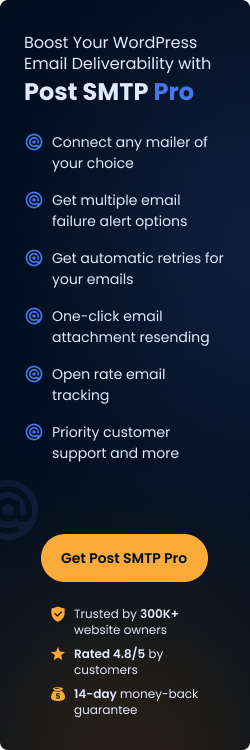Email spamming has become one of the most severe problems in today’s digital age – and an email blacklist has proven to be highly effective in combating it.
But sometimes, legitimate email senders suffer unfair blacklisting, which can be frustrating. To avoid email blacklisting, website owners should follow best practices for email marketing, such as obtaining permission from recipients before sending marketing emails and ensuring that their emails include a clear and easy-to-use unsubscribe link.
In this article, we will explain what an email blacklist is, how to avoid it, and what to do if your email has been blacklisted. Ready? Let’s get started!

What is an Email Blacklist?
An email blacklist is a list of email addresses, domains, or IP addresses identified as sources of spam or other unwanted email. These lists are compiled and maintained by various organizations, including Internet Service Providers (ISPs), email service providers, and anti-spam organizations.
When an email server receives a message, it may consult one or more of these blacklists to check whether the sender’s email address or IP address is listed. If it is, the message may be rejected or flagged as spam. This can result in the sender’s emails being blocked from reaching their intended recipients.
Also read: https://postmansmtp.com/grow-email-list/
How to Avoid an Email Blacklist?
When you send emails, your emails are processed and filtered by various servers and spam filters along the way to your recipient’s inbox. If your emails are marked as spam or suspicious, they could end up on an email blacklist, which means your emails won’t be delivered to your recipients’ inboxes. To avoid getting blacklisted, here are some tips:
- Use a reputable email service provider: Using a reputable email service provider can help ensure that your emails are delivered and that you’re following best practices.
- Build a high-quality email list: Only send emails to people who have opted in to receive them. Avoid purchasing email lists or scraping email addresses from websites. If someone reports your email as spam, it can hurt your sender’s reputation.
- Use a clear and recognizable sender name: Make sure your sender name is clear and recognizable to your recipients. Using a name or email address that recipients don’t recognize can increase the likelihood of your emails being marked as spam.
- Use a clear subject line: Your subject line should be clear and compelling but not misleading. Avoid using all caps or too many exclamation points, as these can trigger spam filters.
- Include an unsubscribe link: Make it easy for recipients to unsubscribe from your emails. If someone can’t figure out how to unsubscribe, they’re more likely to mark your email as spam.
- Monitor your sender’s reputation: Check your sender’s reputation regularly to see if your emails are being marked as spam or suspicious. If you notice a high bounce rate or low engagement, it could be a sign that you need to change your email strategy.
How to Check if You Are on an Email Blacklist?
A perfect or recycled spam trap can occasionally elude detection and get you blacklisted.
Fortunately, your email provider will typically let you know when this occurs. However, if you want to be 100% certain that your IP address or domain isn’t listed on a blacklist, utilize software like Sender Score that checks blacklists.
There are several techniques to determine if you are on a blacklist that includes but is not limited to:
- Monitor Email Metrics: If your open rates have drastically decreased, there’s a good sign that you might be blacklisted. For instance, dropping rapidly from 40% to 5% is unquestionably a clue that something is wrong.
- Send a Test Email: Test emails can be sent to well-known recipients to see whether or not they are opened. The emails may be going to the spam folder.
- Use Email Monitor: Blacklists are automatically checked by email monitors like MassMailer Email Monitor, and they provide a range of services and functionality, including:
- Metrics for predicting deliverability
- Monitoring of blacklists and whitelists
- Testing the email client preview
What To Do If You Are on An Email Blacklist?
Being on an email blacklist can be a frustrating and challenging experience, as it can significantly impact your ability to send and receive emails. Here are some steps you can take to resolve the issue:
Identify the blacklist:
The first step to resolving the issue is identifying the blacklist(s) your email address or domain is listed on. You can use several free online tools to check your email reputation, such as MXToolbox, BarracudaCentral, Spamhaus, and others. These tools scan several public and private blacklists and provide information about your email reputation and whether your email address or domain is listed on any of the blacklists.
Review the blacklist criteria:
Once you have identified the blacklist(s) your email address or domain is listed on, review the criteria for each one. Each blacklist has criteria for listing email addresses or domains; some are stricter than others. It’s essential to understand the reason for the listing so you can take the necessary corrective actions.
Fix the issue:
The next step is to fix the issue that caused your email address or domain to be blacklisted. Common reasons for blacklisting include sending spam, having a compromised account, or having an incorrectly configured email server.
If you are sending spam, you need to identify the source of the spam and stop it. If your account has been compromised, change your password immediately and take other necessary measures to secure your account. If your email server is incorrectly configured, work with your IT team or email service provider to resolve the issue.
Request removal:
Once you have fixed the issue that caused the blacklisting, you can request removal from the blacklist(s). Most blacklists have a process for requesting removal. Follow the instructions provided by the blacklist and provide any necessary information to prove that you have resolved the issue.
Depending on the blacklist, it may take some time for your email address or domain to be removed from the list. Be patient and monitor your email reputation and deliverability during this time.
Monitor your email reputation:
After requesting removal, monitor your email reputation and delivery rates to ensure that your emails are delivered to the inbox instead of being marked as spam. You can use email deliverability tools like Return Path to monitor your email reputation and identify any issues that need to be addressed.
Additionally, if you need to stop sending certain emails, you can do so with Postman SMTP’ functionality called Mail Control. With this extension, you can stop the email sending.
Take preventive measures:
To prevent future blacklisting, follow email best practices such as using double opt-in for email subscriptions, keeping your email list clean, avoiding spam trigger words, and regularly monitoring your email sending practices.
Here, Post SMTP – WordPress SMTP Plugin that allows you to keep track of whether your email is sent or not through multiple notification options such as integration with Twilio (SMS), Slack, Pushover, and Chrome Extention.
Consider using email deliverability tools:
Use email deliverability tools if you are serious about maintaining good email deliverability. These tools can help you monitor your email reputation and deliverability, test your email content for spam triggers, and provide actionable insights to improve your email deliverability.
Final Words
If you discover you are on an email blacklist, investigate the situation to determine the source and fix it. Your low deliverability rate might be the hurdle you are not paying enough attention to. Either the quality of your email copy is not up to the mark, or there might be some technological issues. Identify the issue and use the right tool to come out of the list.
Frequently Asked Questions
How do emails get blacklisted?
When email service providers or recipients mark emails as spam, and after a certain number of complaints, they get blacklisted. This can happen for various reasons, such as sending too many emails, having a low open rate, using misleading subject lines, or having a poor sender reputation.
How do you prevent blacklisting?
You can prevent blacklisting by following some best practices for email marketing, such as segmenting your audience, personalizing your messages, providing value and relevance, asking for permission and feedback, and monitoring and improving your email metrics.
How do I know if my email is blacklisted?
If your email address or domain is blacklisted, you can check it with online tools that check against various blacklists. These tools include MX Toolbox, MultiRBL, and Email Blacklist Check. You can also look for signs such as high bounce rates, low deliverability rates, or spam complaints.
What to do if you have been blacklisted?
Once you find out your email address has been blacklisted, take immediate action to restore your email reputation. Some steps you can take are: identifying the cause of the problem, contacting the blacklist operator and requesting removal, improving your email practices, and implementing preventative measures.


